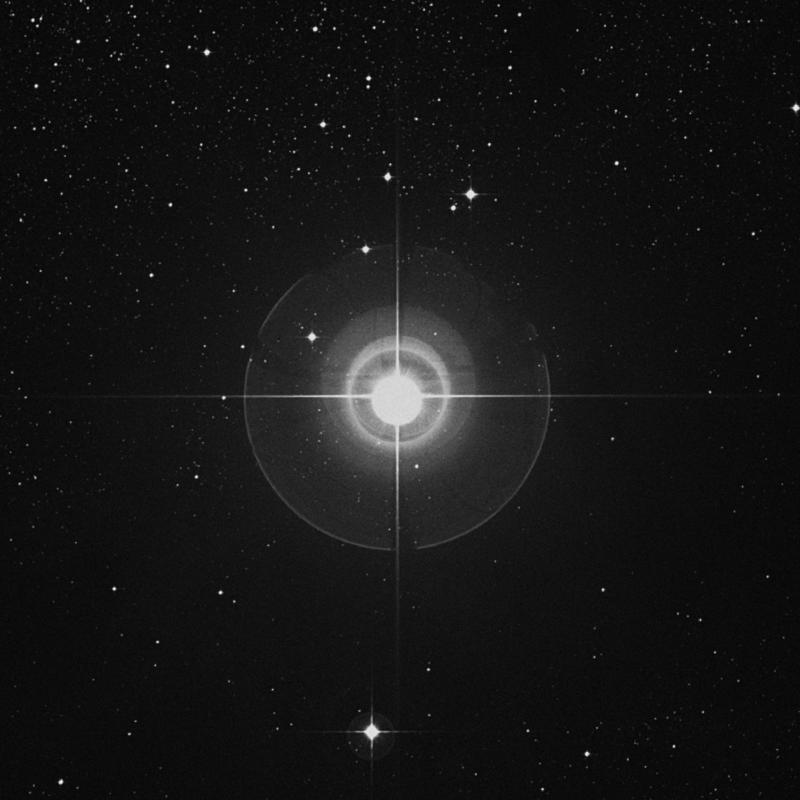Serpens Constellation contains five named stars which, as approved by the International Astronomical Union (IAU), are Alasia, Alya, Gudja, Kaveh and Unukalhai. There are more than 15 stars with known planets, and there is one star brighter than magnitude 3.00 and two stars located within 10 parsecs, 32.6 light years, of Earth. The brightest star in the constellation is Unukalhai with an apparent magnitude of 2.63, and the nearest star is GJ 1224 which is located 24.60 light years from Earth.
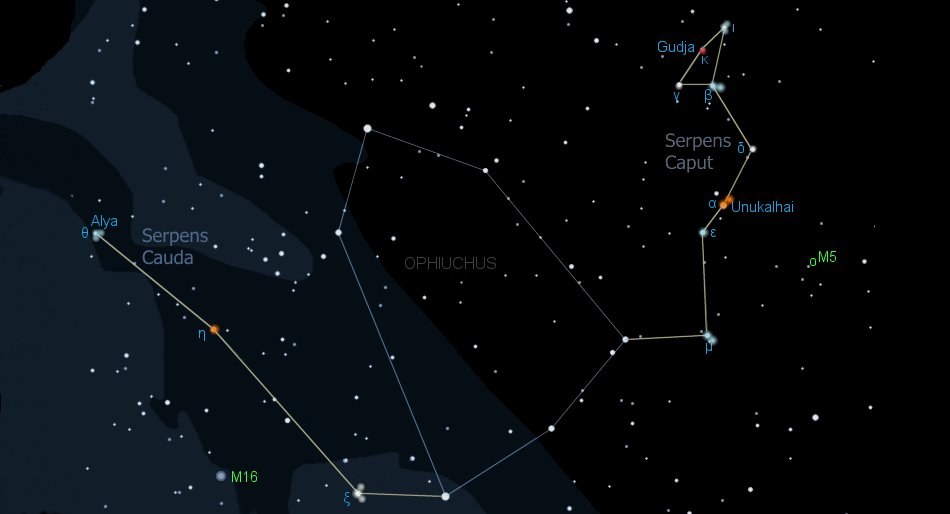
The constellation is also home to one of the best known nebulae, the Eagle Nebula, as well as two Messier objects — Messier 5 and Messier 16 — and other interesting deep sky objects such as the ring galaxy known as Hoag’s Object, the Red Square Nebula and the emission nebula IC 4703. There are two meteor showers associated with the constellation, the Omega Serpentids, peaking on December 26, and the Sigma Serpentids, peaking on December 27.
History and Mythology of the Serpens Constellation
The Serpens constellation dates back to Babylonian times, with the Babylonians having two snake constellations; one represented a hybrid of a dragon, lion and bird, while the other was a horned serpent.
The constellation represents a giant snake in Greek mythology. This snake is being held by the healer Asclepius, represented by Ophiuchus constellation. Asclepius was the son of Apollo who was said to be able to bring people back from the dead with his healing powers. In one story, Apollo killed a snake and saw it be brought back to life by a herb that another snake placed on it.
Asclepius, who is seen holding the top half of the snake in his left hand and the tail in his right hand in the constellation, was said to have used the same technique.
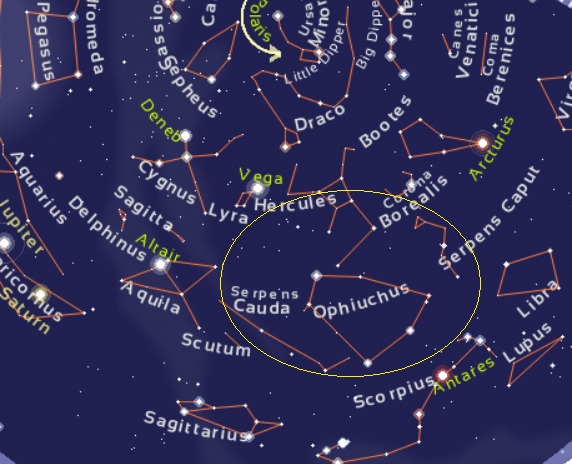
Location of the Serpens Constellation
The constellation of Serpens is the 23rd largest constellation out of the 88 modern constellations and occupies an area of 637 square degrees. It can be seen at latitudes between +80° and -80°. Serpens Caput, which is the western part of the constellation representing the serpent’s head, is located in the third quadrant of the northern hemisphere (NQ3), while Serpens Cauda, which is the eastern part representing the serpent’s tail, is found in the third quadrant of the southern hemisphere (SQ3).
Serpens Caput’s right ascension is 15h 10.4m to 16h 22.5m and its declination is 25.66° to −03.72°. The Serpens Cauda’s right ascension is 17h 16.9m to 18h 58.3m and its declination is 06.42° to −16.14°. The constellation is best seen at 9pm during the month of July.
Serpens Caput’s neighboring constellations are Boötes, Corona Borealis, Hercules, Libra, Ophiuchus and Virgo. While Serpens Cauda’s are Aquila, Ophiuchus, Sagittarius and Scutum. As a whole, the constellation belongs to the the Hercules family of constellations, along with Aquila, Ara, Centaurus, Corona Australis, Corvus, Crater, Crux, Cygnus, Hercules, Hydra, Lupus, Lyra, Ophiuchus, Sagitta, Scutum, Sextans, Triangulum Australe and Vulpecula.
Notable Stars
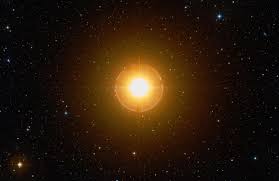
Unukalhai
Unukalhai, also known as Alpha Serpentis, is the brightest star in the constellation of Serpens and has an apparent magnitude of 2.623. It is located near in the serpent’s head, around 74 light years away from the Sun. Its name is derived from the Arabic ‘Unuq al-Ħayyah, which means “the serpent’s neck”.
Unukalhai is a double star, with the primary component being an orange giant with the stellar classification of K2 III. It has a radius that is about 12 times that of the Sun and is 38 times more luminous than the Sun. The companion is located at an angular separation of 58 seconds of arc and has a visual magnitude of 11.8, while a 13th magnitude star can be found 2.3 arc minutes away.
Eta Serpentis
Eta Serpentis is the second brightest star in the constellation and has an apparent magnitude of 3.260. It has the stellar classification of K0 III-IV and is an orange star, halfway between the subgiant and giant evolutionary stage.
Eta Serpentis has a radius that is 5.897 times that of the Sun and a mass double that of the Sun. It is also 19 times more luminous than the Sun. It is located 60.5 light years away from Earth in Serpens Cauda, the serpent’s tail.
Mu Serpentis
Mu Serpentis is the third brightest star in the constellation of Serpens and is located 156 light years away from the Solar System in Serpens Caput, the serpent’s head. It has an apparent magnitude of 3.54.
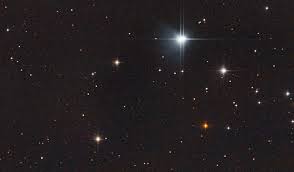
Alya
Alya, also known as Theta Serpentis, is a multiple star system with a combined apparent magnitude of 4.03 and located around 32 light years away from the Sun.
The two main components are Theta-1 and Theta-2 Serpentis, both main sequence dwarfs belonging to stellar classes A5V and A5Vn. They are separated by 22 arc seconds and have an orbital period of at least 14,000 years.
Theta-1 is the brighter component with a visual magnitude of 4.62 and is 18 times more luminous than the Sun, while Theta-2 has an apparent magnitude of 4.98 and is 3 times more luminous than the Sun. Their mass and radius are both about twice that of the Sun and their surface temperatures are 8,000 kelvins.
The third component is a yellow star of the spectral type G5. It is located 7 arc minutes away from Theta-2 Serpentis and has a visual magnitude of 6.71.
The name Alya is derived from the Arabic ’alyah, which means “the fat tail (of a sheep)”.
Beta Serpentis
Beta Serpentis is a multiple star system that is a member of the Ursa Major Moving Group of stars. It has the stellar classification of A3V and an apparent magnitude of 3.65. The system is located 153 light years away from Earth.
The primary component is a white main sequence star and it has two companions. One is located 31 arc seconds from it and has a visual magnitude of 9.9, while the other is located 201 arc seconds from the primary and has a visual magnitude of 10.7.
Delta Serpentis
Delta Serpentis is located in Serpens Caput, around 210 light years away from our Solar System. It is a star system with a combined apparent magnitude of 3.80 and is composed of two binary stars separated by 66 arc seconds.
The primary component in Delta Serpentis is a yellow white subgiant star with a visual magnitude of 4.2, but it is also classified as a Delta Scuti type variable, meaning it shows variations in luminosity by 0.04 magnitudes with a period of 0.134 days.
Its binary companion has an apparent magnitude of 5.2 and is also an F-type subgiant, located four arc seconds away. They orbit each other with a period of 3,200 years.
The second binary pair are separated by 4.4 arc seconds and are a 14th magnitude star and a 15th magnitude star.
Epsilon Serpentis
Epsilon Serpentis is located in Serpens Caput, around 70.3 light years away from Earth. It has an apparent magnitude of 3.71 and is white main sequence dwarf belonging to the spectral class A2Vm.
Epsilon Serpentis is 12 times more luminous than the Sun and has a radius 1.8 times that of the Sun.
Gamma Serpentis
Gamma Serpentis is located in Serpens Caput, around 36.3 light years away from the Solar System. It is a yellow-white main sequence dwarf belonging to the spectral class F6 V and has an apparent magnitude of 3.85. It is thought to be a suspected variable and is 3.02 times more luminous than the Sun. Gamma Serpentis also has a mass 1.30 times that of the Sun and a radius that is 1.55 times that of the Sun. Furthermore, it has two 10th magnitude optical companions.
Xi Serpentis
Xi Serpentis is located about 105 light years from Earth and has a visual magnitude of 3.54. It is a triple star system, with the primary component being a yellow-white giant with the stellar classification F0IIIp. It is also a spectroscopic binary star with an orbital period of 2.29 days. The third component is located 25 arc seconds away from the main pair and is a 13th magnitude star.
Kappa Serpentis
Kappa Serpentis is located in Serpens Caput, about 348 light years away from Earth. It is a red giant star of the spectral type M1III, with an apparent magnitude of 4.09.
Nu Serpentis
Nu Serpentis is a binary star belonging to the spectral class A0/A1V. The primary star is a white main sequence dwarf with a visual magnitude of 4.32, while the companion is located 46 arc seconds away and has a magnitude of 8.4. The star system is located around 193 light years away from Earth.
Lambda Serpentis
Lambda Serpentis is a yellow dwarf star with the stellar classification of G0 V and an apparent magnitude of 4.43. 1.94 times more luminous than the Sun, it is a suspected variable and has a mass 1.14 times that of the Sun and a radius 1.318 times that of the Sun.
It is located around 38.3 light years away from the Sun but is currently moving towards the Sun. In around 166,000 years it will come within 7.371 light years of the Solar System.

Chi Serpentis
Chi Serpentis is a white main sequence dwarf of the spectral type A0p Sr with an apparent magnitude of 5.34. It is an Alpha-2 Canum Venaticorum type variable, which is a chemically peculiar star exhibiting magnitude variations by 0.03 over a period of 1.596 days. It is located around 228 light years away from the Solar System.
Tau Serpentis
Tau Serpentis is located in Serpens Caput and is a Bayer designation shared by eight stars:
-
Tau-1 Serpentis
Also known as 9 Serpentis, is a red giant belonging to the spectral class M1III with a visual magnitude that ranges from 5.13 to 5.20. It has an absolute magnitude of -2.1 and a radius 54 times that of the Sun. It is located around 900 light years away from the Sun.
-
Tau-2 Serpentis
Also known as 12 Serpentis, is a blue-white main sequence star of the spectral type B9V with an apparent magnitude of 6.218. It is located 430 light years away from Earth.
-
Tau-3 Serpentis
Also known as 15 Serpentis, is a yellow giant belonging to the stellar class of G8III and has an apparent magnitude of 6.108. It is approximately 410 light years away from the Solar System.
-
Tau-4 Serpentis
Also known as 17 Serpentis, is a red bright giant belonging to the spectral class M5II-III. Because it is classified as a semi-regular variable star, it has a visual magnitude that varies from 5.89 to 7.07 with a period of about 100 days. It is around 520 light years away from the Sun.
-
Tau-5 Serpentis
Also known as 18 Serpentis, is a yellow-white main sequence dwarf of the spectral type F3V with an apparent magnitude of 5.938. It has a mass that is 1.52 times that of the Sun and is around 160 light years away from Earth.
-
Tau-6 Serpentis
Also known as 19 Serpentis, is a yellow giant star belonging to the stellar class of G8III and has a visual magnitude of 6.00. It is a member of the Ursa Major Stream and is located about 450 light years away from the Solar System. It has a radius that is 11 times that of the Sun.
-
Tau-7 Serpentis
Also known as 22 Serpentis, is a white star that belongs to the spectral class A2m and has an apparent magnitude of 5.804. It is located around 174 light years away from Earth.
-
Tau-8 Serpentis
Also known as 26 Serpentis, is a white main sequence dwarf with the stellar classification of A0V and an apparent magnitude of 6.144. Its radius is twice that of the Sun and it is located 320 light years away from the Solar System.
R Serpentis
R Serpentis is a red giant with the stellar classification of M7IIIe and an apparent magnitude of 7.1. It is located approximately 900 light years away from the Sun.
R Serpentis is also a Mira variable, meaning it is a pulsating variable star, very red in color, that will expel its outer envelope to form a planetary nebula and become a white dwarf within a few million years.
HD 168443
HD 168443 is a yellow main sequence star with the stellar classification of G5IV and a visual magnitude of 6.92. It is located around 123.5 light years away from the Solar System and has a confirmed planet and a brown dwarf in its orbit. The brown dwarf has an orbital period of 1,739.5 days and a mass that is 17.378 times that of Jupiter. The planet has an orbital period of 58.116 days and a mass that is 7.696 times that of Jupiter.
HD 136118
HD 136118 is a yellow-white dwarf with the stellar classification of F9V and an apparent magnitude of 6.94. It is located around 171 light years away from Earth.
A massive planet was discovered to be orbiting the star in February 2002. American astronomer Debra Fischer made the discovery, which turned out to be a brown dwarf that has a mass 42 times that of Jupiter and an orbital period of 1,209 days.
Gliese 710
Gliese 710 is an orange main sequence dwarf with the stellar classification of K7 Vk and an apparent magnitude of 9.69. The star is a suspected variable, with variations in magnitude ranging from 9.65 to 9.69.
Gliese 710 is located around 63.8 light years away from Earth and has a mass that is 60 percent that of the Sun’s and a radius that is 67 percent. Within the next 1.4 million years, the star will approach the Sun within a very small distance, possibly under one light year. When this happens, Gliese 710 will be as bright as Antares, the brightest star in Scorpius constellation.
Deep Sky Objects
Messier 5
Messier 5, also known as M5 or NGC 5904, is a globular cluster with an apparent magnitude of 6.65. It was first discovered by German astronomer Gottfried Kirch in 1702, then by Charles Messier in 1764, but he thought it was a nebula. German-born British astronomer William Herschel was the first to discover individual stars in the cluster in 1791.
Messier 5 is home to over 100,000 stars, 105 of them being variable stars and 97 to be RR Lyrae variables. The brightest starts in the cluster have an apparent magnitude of 12.2 and the cluster can be seen without binoculars in extremely good conditions.
The cluster is about 13 billion years old, making it one of the oldest known clusters in our Milky Way. It is located approximately 24,500 light years away from Earth and has a radius that is around 80 light years.
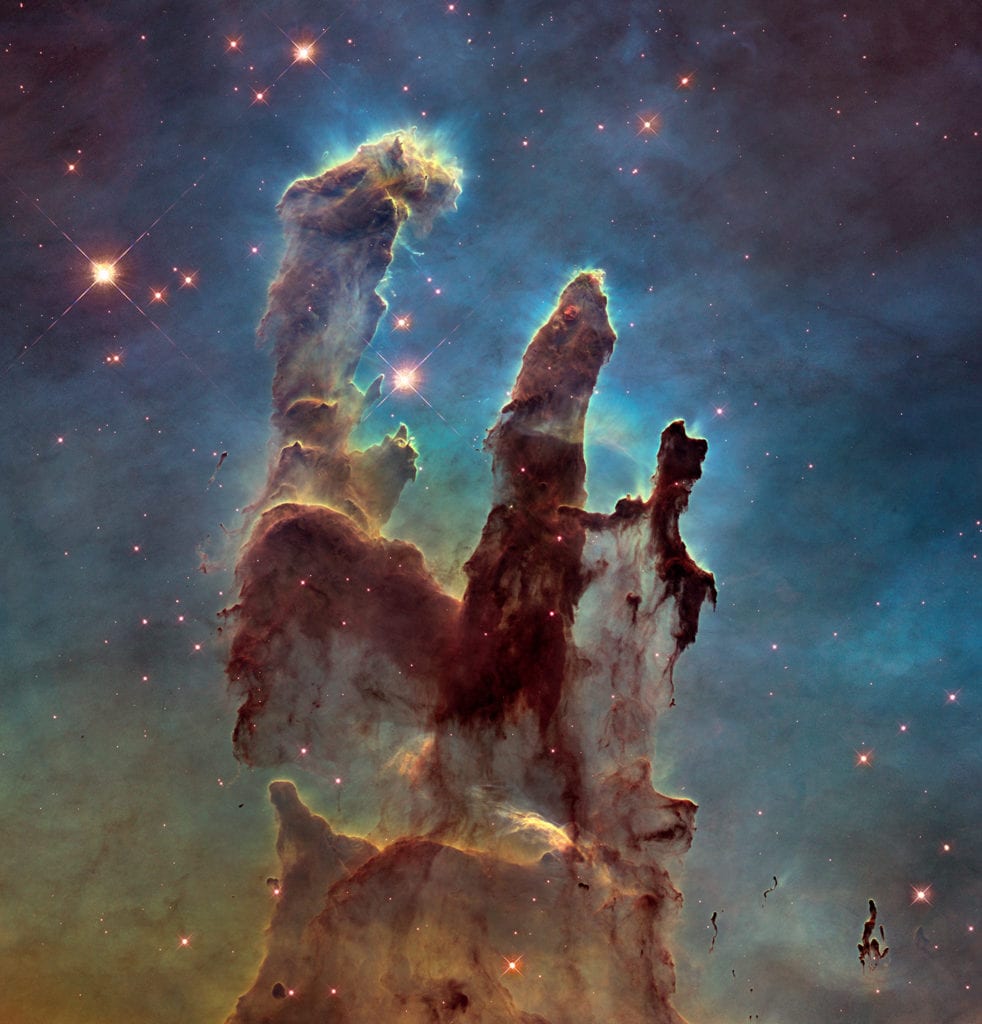
The Eagle Nebula
The Eagle Nebula, also known as Messier 16, M16, NGC 6611 and sometimes even the Star Queen Nebula, is a nebula with a young open star cluster that was discovered by the Swiss astronomer Jean-Philippe de Chéseaux in 1745. M16 is part of the diffuse emission nebula IC 4703 and roughly resembles an eagle, which is how it got its name.
Messier 16 contains the Pillars of Creation, which are a large region of star-formation. They are thought to already have been destroyed by a supernova explosion between 8,000 to 9,000 years ago, but this image will likely not reach Earth for another 1,000 years.
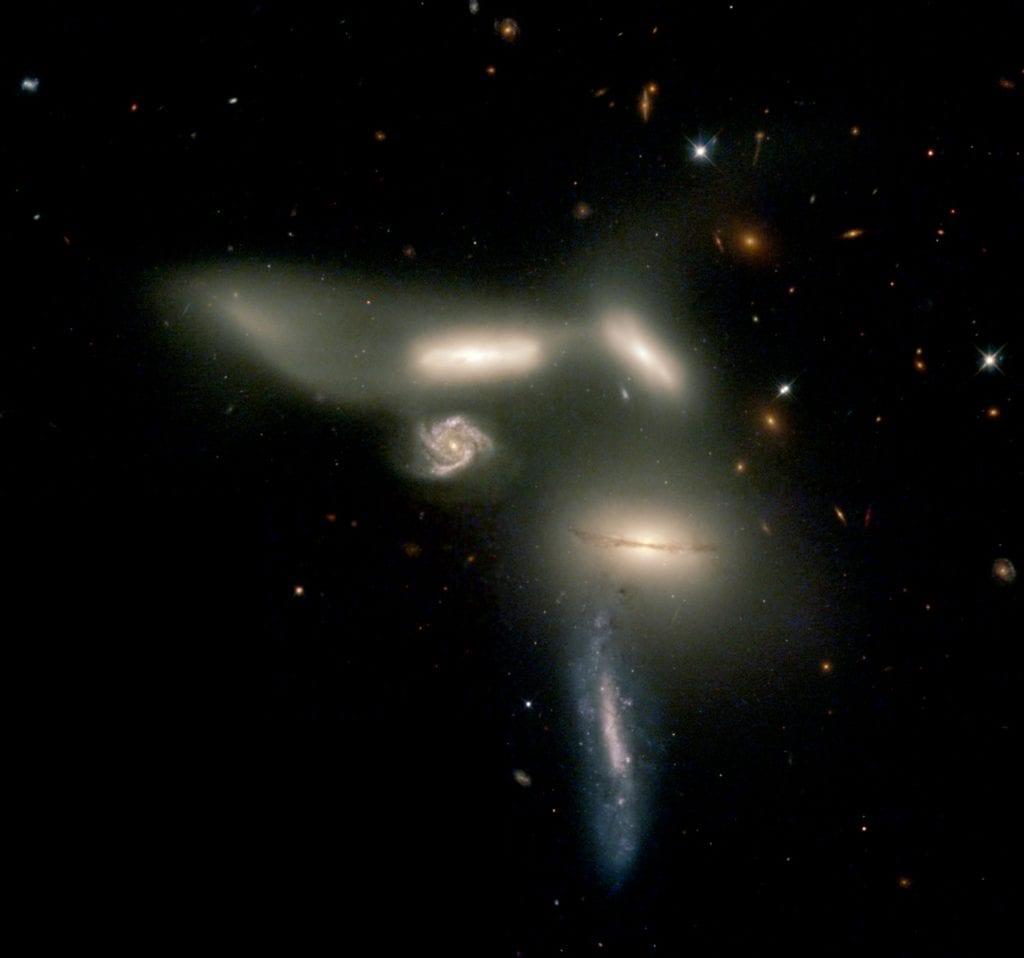
Seyfert’s Sextet
Seyfert’s Sextet is a group of six galaxies that are located in Serpens Caput, around 190 million light years away from Earth. They were named after American astronomer Carl Keenan Seyfert, who discovered them in the 1950s.
Four of the galaxies are physically related, while one is a background object and the other is a separated part of one of the other galaxies that belongs to the group. The four galaxies that are physically related will eventually merge to form a single giant elliptical galaxy.
The brightest galaxy in Seyfert’s Sextet is NGC 6027, which is a lenticular galaxy, and has an apparent magnitude of 14.7. It was discovered by the French astronomer Édouard Stephan in 1882 and is located around 190 million light years away from Earth.
NGC 6027a is a spiral galaxy that bears a strong resemblance to the Sombrero Galaxy in Virgo constellation and has a visual magnitude of 14.9.
The NGC 6027b is a S0 peculiar galaxy with an apparent magnitude of 15.3. NGC 6027c is a spiral galaxy with a visual magnitude of 16.7.
NGC 6027d is a spiral galaxy with an apparent magnitude of 16.5. While it is not interacting with the other galaxies, it lies in the same line of sight and is located around 877 million light years away from Earth. NGC 6027e is a tidal tail of NGC 6027 and has an apparent magnitude of 16.7.
IC 4703
IC 4703 is a diffuse emission nebula and an active star forming region, associated with the Eagle Nebula. It is located in Serpens Cauda, around 7,000 light years from Earth. It is a magnitude 8 nebula that surrounds Messier 16.
IC 4756
IC 4756 is an open star cluster that is located around 1,300 light years away from the Solar System.
Red Square Nebula
The Red Square Nebula, also known as MWC 922, is a bipolar nebula that is notable for its square shape. It is one of the most symmetrical deep sky objects ever discovered, but it is unclear how the central star, MWC 922, produces the nebula’s shape.
Hoag’s Object
Hoag’s object is a ring galaxy located in Serpens Caput, around 600 million light years away from the Solar System. It was first discovered by American astronomer Arthur Allen Hoag in 1950, which is how it got its name.
Hoag’s object has an almost perfect ring structure that is formed by young hot blue stars surrounding the older galaxy nucleus. It is slightly larger than the Milky Way Galaxy, with the inner core measuring around 17,000 light years in diameter, the surrounding ring measuring 75,000 light years in diameter and the outer diameter measuring 121,000 light years. It has an apparent magnitude of 16.0.
Serpens South Star Cluster
The Serpens South Star Cluster is a group of about 50 stars that is located around 848 light years away from Earth. 35 of the stars are protostars, only starting to take shape.
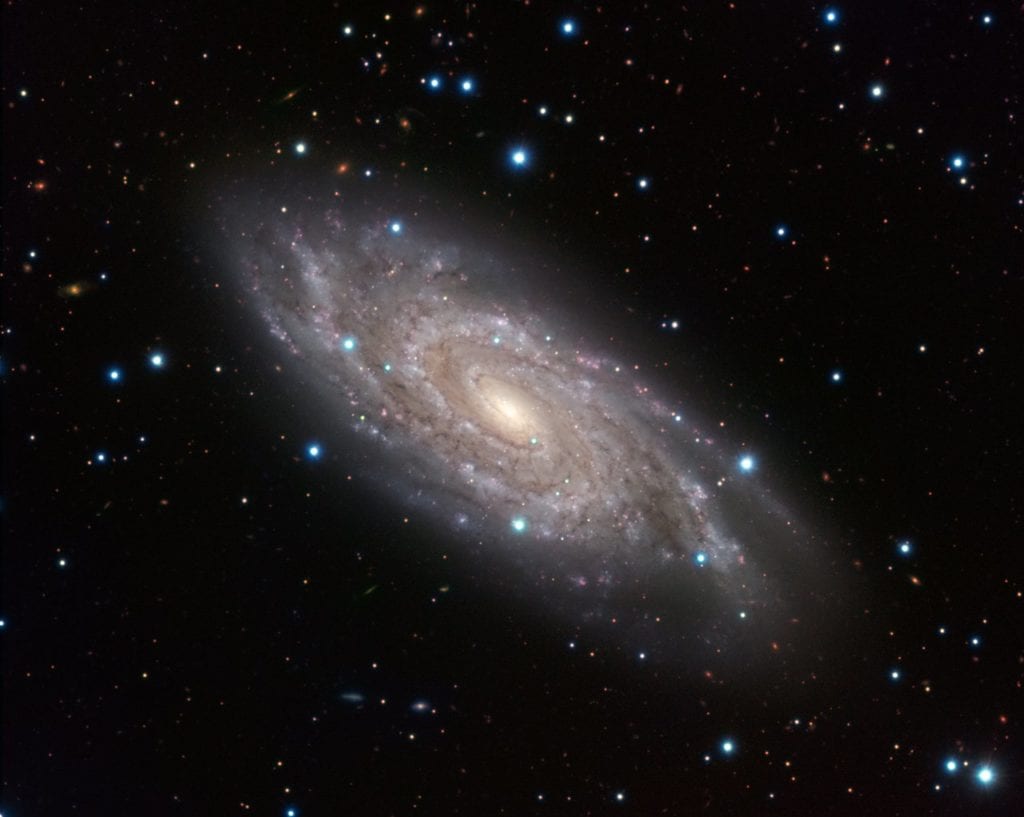
Blinking Galaxy
The Blinking Galaxy, also known as NGC 6118, is a grand design spiral galaxy that is located around 82.9 million light years away from the Solar System. It has an apparent magnitude of 12.42 and is therefore relatively faint, making it difficult to observe with a small telescope. Its name “Blinking Galaxy” was given to it as it tends to come in and out of view depending on the eye position.
NGC 6118 is roughly the same size as the Milky Way, measuring around 110,000 light years across. On August 1, 2004 a Type Ib supernova, SN2004dk, was discovered in the galaxy.
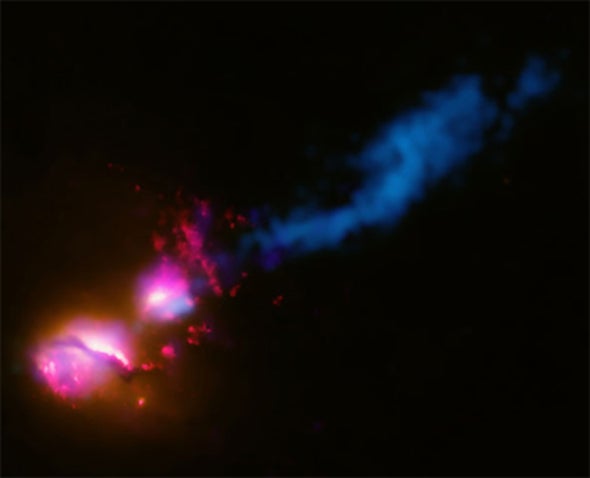
Death Star Galaxy
The Death Star Galaxy, also known as 3C 321, are actually a pair of galaxies rotating around each other. They are situated around 370 megaparsecs (1207 megalight-years) from Earth. The galaxies were the first example of one galaxy blasting another galaxy with a stream of energy, which is believed to come from from the first galaxy’s supermassive black hole.
NGC 6539
NGC 6539 is a globular star cluster with an apparent magnitude of 9.6 that was first discovered by the Danish astronomer Theodor Brorsen in 1856. It is located around 25,400 light years away from Earth.
NGC 5962
NGC 5962 is a spiral galaxy located in Serpens Caput that was discovered by the German-born British astronomer William Herschel in 1784 using a Newtonian reflector telescope. It has an apparent magnitude of 11.3 and is the brightest galaxy in the Serpens galaxy cluster.
The NGC 5962 galaxy has three smaller satellites, all dwarf galaxies, and a central bulge with a relatively large core region.
NGC 5964
The NGC 5964 object is a spiral galaxy with an apparent magnitude of 12.6.
NGC 5970
NGC 5970 is a large barred spiral galaxy that is located in Serpens Caput, around 90 million light years away from the Solar System and about a degree to the southwest of the star Chi Serpentis. It has an apparent magnitude of 11.5 and appears face-on when observed from Earth.
NGC 5921
NGC 5921 is a barred spiral galaxy with an apparent magnitude of 11.5. In 2001, a supernova, SN 2001X, was observed in the galaxy.
NGC 5972
NGC 5972, also known as UGC 9946, is a spiral galaxy that was first discovered by the French astronomer Édouard Jean-Marie Stephan on June 29, 1880. It has an apparent magnitude of 13.4 and is located around 410 million light years away from Earth. It occupies an area 1’.0 × 0.7 in size.
NGC 6535
NGC 6535 is a globular cluster that was first discovered by the English astronomer John Russell Hind on April 26, 1852. It has a visual magnitude of 9.3 and is located about 22,200 light years away. It measures around 1 light year across.
NGC 6604
NGC 6604 is an open cluster with an apparent magnitude of 6.5. It is located around 5,500 light years away from us, about 2 degrees to the north of the Eagle Nebula.
Arp 220
Arp 220 is a deep sky object that was formed by a collision of two galaxies that are currently in the process of merging. It is the brightest of the three galactic mergers closest to Earth, about 250 million light years away. It measures around 5,000 light years across and has an apparent magnitude of 13.9.
Arp 220 glows brightest in infrared light and is an ultra-luminous infrared galaxy. In October 2011, 7 supernovae were observed in the galaxy at the same time.
Sh2-54
Sh2-54 is an extended bright emission nebula which is part of an extended nebulous region which also includes the Eagle Nebula and the Omega Nebula in Sagittarius constellation. It is around 140 arc minutes in size contains many infrared sources and many protostars. It is located around 6,200 light years away from the Solar System and the oldest stars are thought to be between 4 to 5 million years old.
Palomar 5
Palomar 5 is a globular cluster that was discovered by the German astronomer Walter Baade in 1950 and then independently discovered by the American astronomer Albert George Wilson in 1955.
It is located around 76,000 light years away from the Solar System and has an apparent magnitude of 11.75. It measures around 76 light years in radius.
Westerhout 40
Westerhout 40, also known as W40, is a star-forming region that is one of the nearest regions of formation of high-mass O- and B-type stars. It is located 1,420 light years from Earth but is difficult to observe in visible light because it is obscured by the molecular cloud in which the stars were formed.
W40 measures 8 arc minutes in size and contains an open cluster of about 520 young stars. In the center region of the cluster the stars around 0.8 million years old, while the stars in the outer region are around 1.5 million years old.
Extra Facts
- The International Astronomical Union adopted the three-letter abbreviation “Ser” for the constellation in 1922.
- Serpens appears prominently in both the northern and southern skies during the Northern Hemisphere’s summer.
- In Chinese astronomy, most of the stars of Serpens represented part of a wall surrounding a marketplace, known as Tianshi, which was in Ophiuchus and part of Hercules.
- Serpens Caput’s boundaries, as set by Belgian astronomer Eugène Delporte in 1930, are defined by a 10-sided polygon, while Serpens Cauda’s are defined by a 22-sided polygon.
Images:
- Some Images created with the NightVision app – https://www.nvastro.com/nvj.html
- Some Images created with the Stelvision Sky Map https://www.stelvision.com/en/sky-map/
- Serpens 2 – https://www.go-astronomy.com/constellations.php?Name=Serpens
- Unukalhai – https://www.star-facts.com/unukalhai/
- Eta Serpentis – https://theskylive.com/sky/stars/eta-serpentis-star
- Alya – http://stars.astro.illinois.edu/sow/alya.html
- Chi Serpentis – https://theskylive.com/sky/stars/chi-serpentis-star
- Eagle Nebula – https://www.nasa.gov/feature/goddard/2017/messier-16-the-eagle-nebula/
- Seyfert’s Sextet – https://en.wikipedia.org/wiki/Seyfert%27s_Sextet
- Red Square Nebula – https://apod.nasa.gov/apod/ap160131.html
- Blinking Galaxy – https://www.eso.org/public/images/potw1022a/
- Death Star Galaxy – https://www.scientificamerican.com/gallery/the-death-star-galaxy/
